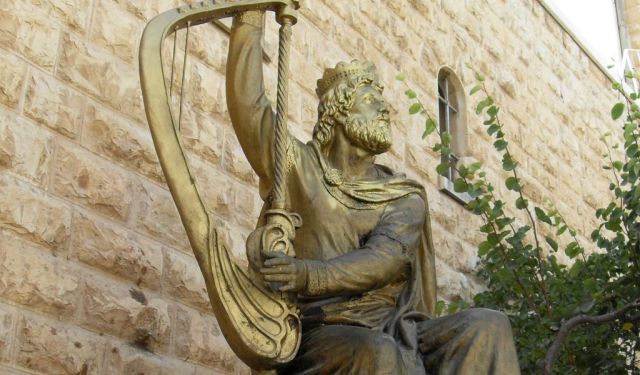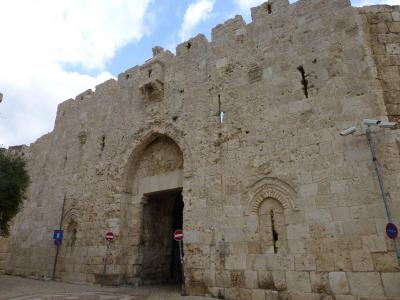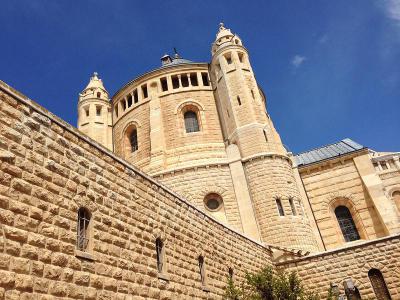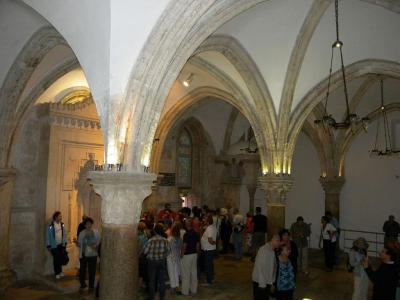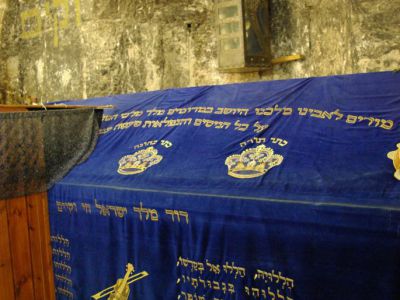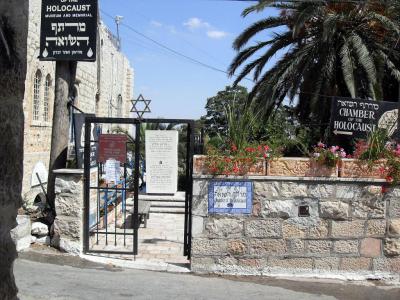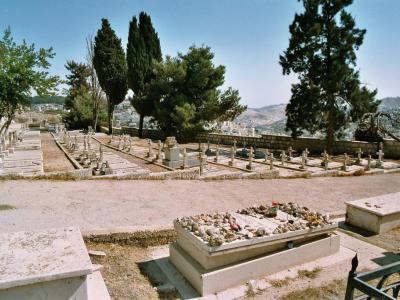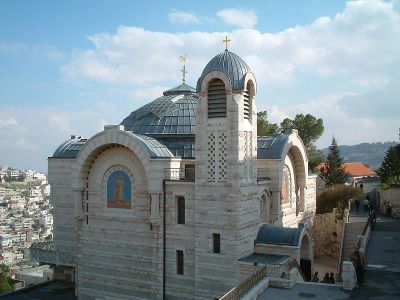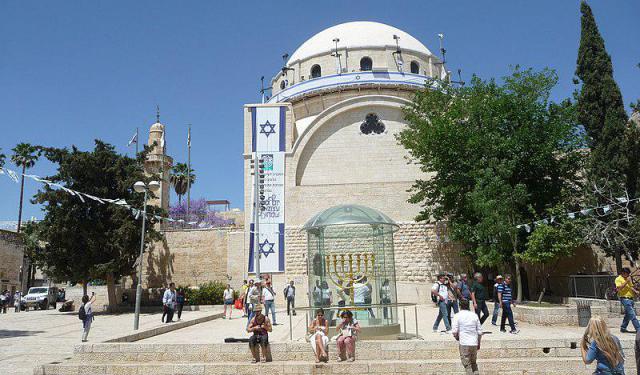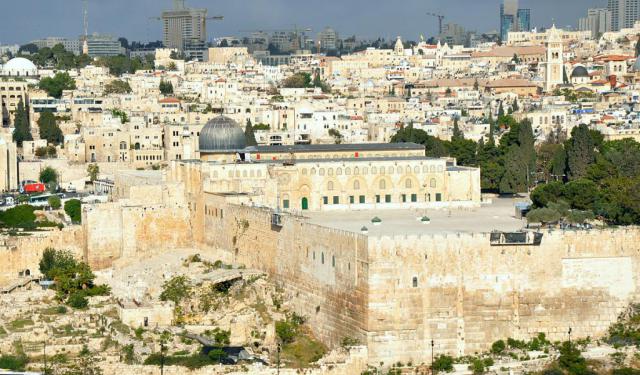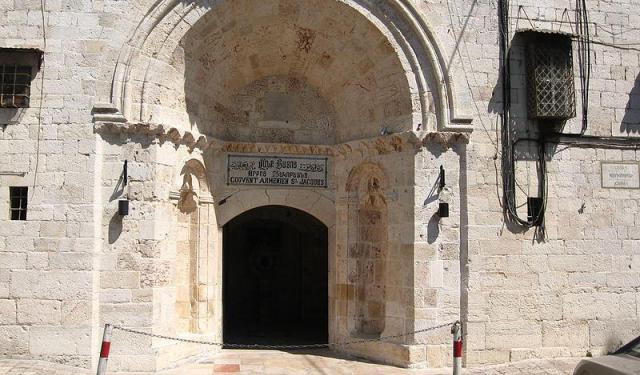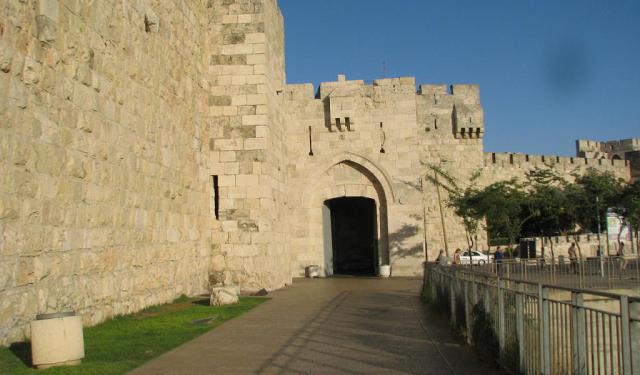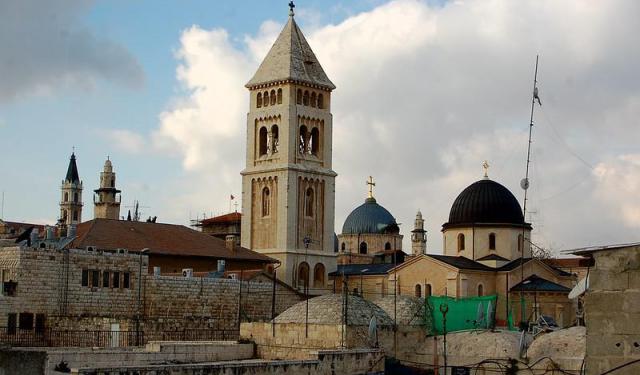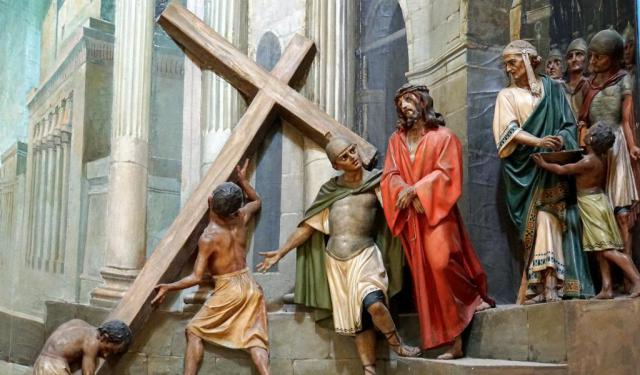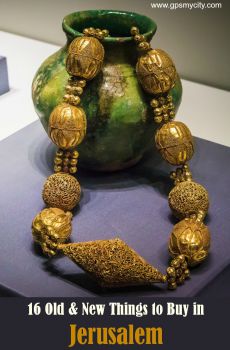Mount Zion Walking Tour (Self Guided), Jerusalem
For those interested in religion and history, Mount Zion offers several unique sights that are situated in close proximity to each other. An important place for Christians, Jews as well as Muslims, it holds important constructions dating from the 20th century as well as a compound built by the Crusaders that marks the spot of both King David’s tomb and the Room of the Last Supper. How interesting is that!?
Exit the Old City through the Zion Gate and head up the hillside to the mount. Before long, you will find the lovely Dormition Abbey and great vistas of the city from multiple vantage points. Explore the area around King David’s Tomb and make sure to wear proper attire if you want to peek inside. The Chamber of the Holocaust, a six-room cellar whose walls are covered with gravestones, sits right beside.
Across the main road to the south, the Protestant cemetery just below Mount Zion houses the tomb of German-born Oskar Schindler, the Holocaust’s most famous “righteous gentile”, an industrialist who managed to save an estimated 1200 Jews from the Nazi death camps, and who, before dying in 1974, asked to be buried in Jerusalem. His efforts were made into a successful film by Steven Spielberg – “Schindler’s List”.
Finally, on the slopes overlooking the City of David, don’t miss the Church of St Peter in Gallicantu commemorating the traditional site of St Peter’s denial of Christ which fulfilled the prophecy, “Before the cock crows twice, thou shalt deny me thrice”.
After completing your visit of Mount Zion, feel free to make your way east along the wall of the Old City, taking in the ruins of the City of David, the monumental tombs of Kidron Valley as well as numerous impressive places at the Mount of Olives nearby. To make the most of these experiences, follow this self-guided tour!
Exit the Old City through the Zion Gate and head up the hillside to the mount. Before long, you will find the lovely Dormition Abbey and great vistas of the city from multiple vantage points. Explore the area around King David’s Tomb and make sure to wear proper attire if you want to peek inside. The Chamber of the Holocaust, a six-room cellar whose walls are covered with gravestones, sits right beside.
Across the main road to the south, the Protestant cemetery just below Mount Zion houses the tomb of German-born Oskar Schindler, the Holocaust’s most famous “righteous gentile”, an industrialist who managed to save an estimated 1200 Jews from the Nazi death camps, and who, before dying in 1974, asked to be buried in Jerusalem. His efforts were made into a successful film by Steven Spielberg – “Schindler’s List”.
Finally, on the slopes overlooking the City of David, don’t miss the Church of St Peter in Gallicantu commemorating the traditional site of St Peter’s denial of Christ which fulfilled the prophecy, “Before the cock crows twice, thou shalt deny me thrice”.
After completing your visit of Mount Zion, feel free to make your way east along the wall of the Old City, taking in the ruins of the City of David, the monumental tombs of Kidron Valley as well as numerous impressive places at the Mount of Olives nearby. To make the most of these experiences, follow this self-guided tour!
How it works: Download the app "GPSmyCity: Walks in 1K+ Cities" from Apple App Store or Google Play Store to your mobile phone or tablet. The app turns your mobile device into a personal tour guide and its built-in GPS navigation functions guide you from one tour stop to next. The app works offline, so no data plan is needed when traveling abroad.
Mount Zion Walking Tour Map
Guide Name: Mount Zion Walking Tour
Guide Location: Israel » Jerusalem (See other walking tours in Jerusalem)
Guide Type: Self-guided Walking Tour (Sightseeing)
# of Attractions: 7
Tour Duration: 1 Hour(s)
Travel Distance: 1.0 Km or 0.6 Miles
Author: vickyc
Sight(s) Featured in This Guide:
Guide Location: Israel » Jerusalem (See other walking tours in Jerusalem)
Guide Type: Self-guided Walking Tour (Sightseeing)
# of Attractions: 7
Tour Duration: 1 Hour(s)
Travel Distance: 1.0 Km or 0.6 Miles
Author: vickyc
Sight(s) Featured in This Guide:
- Zion Gate
- Dormition Abbey
- The Cenacle – Room of the Last Supper
- King David's Tomb
- Chamber of the Holocaust
- Schindler's Grave
- Church of St. Peter in Gallicantu
1) Zion Gate
Lying among the eight gates embedded within the Old City's fortifications, the Zion Gate, also known as David's Gate, serves as a direct passage into the Armenian and Jewish Quarters. If the tales of the famous Jewish king's burial here hold true, the name couldn't be more fitting. With its angular features crafted to thwart invaders, one can now traverse it in the opposite direction and 'invade' the Old City at any hour of the day. Besides, the walls along here are especially nice, offering splendid photo opportunities under the afternoon sun.
Constructed by engineers of Suleiman the Magnificent around 1540, this gate facilitated direct access from the city to the sacred sites atop Mount Zion. In the 19th century, the nearby vicinity gained notoriety as a gathering point for lepers. The battleground was particularly intense here in 1948, as Israeli soldiers struggled to breach the walls to relieve the besieged Jewish Quarter held by the Jordanians. Today, the gate's exterior bears witness to the ferocious combat, marred by numerous bullet holes. A short distance to the west, conspicuous damage to the base of the wall remains from the soldiers' attempts to blast their way through with explosives.
Constructed by engineers of Suleiman the Magnificent around 1540, this gate facilitated direct access from the city to the sacred sites atop Mount Zion. In the 19th century, the nearby vicinity gained notoriety as a gathering point for lepers. The battleground was particularly intense here in 1948, as Israeli soldiers struggled to breach the walls to relieve the besieged Jewish Quarter held by the Jordanians. Today, the gate's exterior bears witness to the ferocious combat, marred by numerous bullet holes. A short distance to the west, conspicuous damage to the base of the wall remains from the soldiers' attempts to blast their way through with explosives.
2) Dormition Abbey
This beautiful, ancient monastery on top of Mount Zion – said to be the place where the Virgin Mary was taken, body and soul, to heaven by angels – is attractive for its distinctive conical roof and rich interior decorations, in addition to its religious significance. After Christ's death, according to Christian tradition, his mother lived on Mount Zion until her eternal sleep; the name "dormition" meaning "falling asleep" or death and the resurrection to heaven.
The church has two levels – the main church and the crypt, both equally impressive, with fine mosaics and Byzantine-style artwork which cover almost every surface, including the floor. Chapels and alters have been donated from around the world and make the tour of the church simply breathtaking, culminating with the ivory sculpture of the resting Mary in the crypt below.
The little shop and quiet cafe are the frostings on the cake; a real haven in the maze complex of the Old City. The cade has comfortable chairs and tables and delicious coffee/cakes, while the shop sells high-quality souvenirs at very reasonable prices, including small hand-painted Russian icons and handcrafted crosses.
Tip:
Make sure to use their 3-shekel bathroom to see the ruins they have there with an explanation!
The church has two levels – the main church and the crypt, both equally impressive, with fine mosaics and Byzantine-style artwork which cover almost every surface, including the floor. Chapels and alters have been donated from around the world and make the tour of the church simply breathtaking, culminating with the ivory sculpture of the resting Mary in the crypt below.
The little shop and quiet cafe are the frostings on the cake; a real haven in the maze complex of the Old City. The cade has comfortable chairs and tables and delicious coffee/cakes, while the shop sells high-quality souvenirs at very reasonable prices, including small hand-painted Russian icons and handcrafted crosses.
Tip:
Make sure to use their 3-shekel bathroom to see the ruins they have there with an explanation!
3) The Cenacle – Room of the Last Supper
Part of the complex that also hosts the Tomb of David on Mount Zion, the ancient Room of the Last Supper resides on the upper floor of a Gothic structure beneath the Dormition Abbey's shadow. Christian tradition maintains that this space, known as the Cenacle (from the Latin "cenaca", meaning "supper room"), has also witnessed the descent of the Holy Spirit upon the eleven apostles after Easter.
Accessible through a doorway with an Ottoman inscription above it, visitors ascend the stairs to the left upon entry. Though slightly smaller than its depiction in da Vinci's renowned painting, the room's layout, with pillars in the middle, might have posed challenges for Jesus and his disciples to gather around a table. Despite debates over authenticity, the room's beauty and tranquility endure.
Constructed long after Jesus's era, during the Crusader period, its architecture is characterized by distinctive pointed arches. Ironically, however, the most exquisite architectural features bear Islamic influences, reflecting the room's history as a mosque for around 400 years until the establishment of the State of Israel following the 1948 war. Standouts include the small but very ornate mihrab and the impressive stained glass windows with vibrant geometric motifs and delicate Quranic inscriptions.
Tip:
Consider accessing the building's rooftop for beautiful views of the Mount of Olives and the neighboring Dormition Abbey.
Accessible through a doorway with an Ottoman inscription above it, visitors ascend the stairs to the left upon entry. Though slightly smaller than its depiction in da Vinci's renowned painting, the room's layout, with pillars in the middle, might have posed challenges for Jesus and his disciples to gather around a table. Despite debates over authenticity, the room's beauty and tranquility endure.
Constructed long after Jesus's era, during the Crusader period, its architecture is characterized by distinctive pointed arches. Ironically, however, the most exquisite architectural features bear Islamic influences, reflecting the room's history as a mosque for around 400 years until the establishment of the State of Israel following the 1948 war. Standouts include the small but very ornate mihrab and the impressive stained glass windows with vibrant geometric motifs and delicate Quranic inscriptions.
Tip:
Consider accessing the building's rooftop for beautiful views of the Mount of Olives and the neighboring Dormition Abbey.
4) King David's Tomb
King David's Tomb holds significant cultural and religious importance for the Jewish community. Particularly during the period between 1948 and 1967 when access to the Old City and the Western Wall was restricted due to Jordanian control, it became an alternative site for Jewish pilgrimage. While some believe it to be the actual burial place of King David, this tradition only dates back to the 10th century AD, shortly after the Crusades. The building itself dates from the Crusader era and is partially open to the public for visitation.
Upon entering, take note of the exquisite tile work in the first antechamber, which was patched to match repairs made to the Dome of the Rock during the 1500s. The second antechamber houses a mihrab with equally impressive tile work dating from the 1400s when the area was under Muslim control. Today, the building serves as a synagogue, with separate entrances for men and women.
Next to the velvet-draped cenotaph and directly beneath the Cenacle is the empty room where Jesus supposedly washed his disciples’ feet after the last supper. Additionally, the building's rooftop features an observation point offering excellent views and a minaret, added by the Turks during the 16th century after the expulsion of Christians from Mount Zion.
Tips:
Modest attire is recommended regardless of gender (kippahs are provided for men).
Though pictures are often allowed, it's important to be respectful of those involved in prayer.
Upon entering, take note of the exquisite tile work in the first antechamber, which was patched to match repairs made to the Dome of the Rock during the 1500s. The second antechamber houses a mihrab with equally impressive tile work dating from the 1400s when the area was under Muslim control. Today, the building serves as a synagogue, with separate entrances for men and women.
Next to the velvet-draped cenotaph and directly beneath the Cenacle is the empty room where Jesus supposedly washed his disciples’ feet after the last supper. Additionally, the building's rooftop features an observation point offering excellent views and a minaret, added by the Turks during the 16th century after the expulsion of Christians from Mount Zion.
Tips:
Modest attire is recommended regardless of gender (kippahs are provided for men).
Though pictures are often allowed, it's important to be respectful of those involved in prayer.
5) Chamber of the Holocaust
Among the lesser-known sites on Mount Zion, this small memorial once acted as Israel's first Holocaust museum. Established in 1949, shortly after the end of World War II, it predates the larger Yad Vashem museum by several years. Housed in a six-room cellar adjacent to the tomb believed by some to be that of King David, it was founded by early settlers who were themselves Holocaust survivors, determined to ensure that the memory of their past experiences would be preserved.
Once you've made your way to the small desk at the entrance, a minimal fee permits you to wander through the several small rooms and a courtyard. There are seldom many other visitors and one is thus left alone for quiet contemplation. With a bit of signage and a dramatic display of artifacts (mostly of Jewish religious context), one gets a sense of the somber mood that was being aimed for. Sometimes referred to as "a cemetery without bodies", this place has headstones without graves, monuments without remains and tombstones for family members who had no real tomb to visit. In this very tangible and affecting way, the full scope of the Holocaust is brought home.
Exiting into the daylight once again reminds of the contrast between present-day Israel and the dark chapters of the past.
Once you've made your way to the small desk at the entrance, a minimal fee permits you to wander through the several small rooms and a courtyard. There are seldom many other visitors and one is thus left alone for quiet contemplation. With a bit of signage and a dramatic display of artifacts (mostly of Jewish religious context), one gets a sense of the somber mood that was being aimed for. Sometimes referred to as "a cemetery without bodies", this place has headstones without graves, monuments without remains and tombstones for family members who had no real tomb to visit. In this very tangible and affecting way, the full scope of the Holocaust is brought home.
Exiting into the daylight once again reminds of the contrast between present-day Israel and the dark chapters of the past.
6) Schindler's Grave
Just south of King David's Tomb and the Chamber of the Holocaust, the Protestant cemetery on Mount Zion is home to the final resting place of Oskar Schindler, the Holocaust's most famous "righteous gentile", whose remarkable efforts to save an estimated 1,200 Jews from the horrors of Hitler's death camps were immortalized in Steven Spielberg's acclaimed film "Schindler's List", based on Thomas Keneally's novel "Schindler's Ark", which won the Booker Prize in 1982.
Despite his Nazi Party membership, Schindler used his position as an industrialist to employ Jewish prisoners in his enamelware and ammunition factories, thereby shielding them from the horrors of the gas chambers. He went to great lengths, including bribery of SS officials, to ensure the safety of his workers until the end of the World War in May 1945, ultimately exhausting his fortune in the process.
After the war, Schindler faced financial hardship but was eventually brought to Israel for burial thanks to the efforts of some of the individuals he had rescued. His grave can be found in the lowest section of the cemetery, marked by stones left by Jewish visitors-a tradition in Jewish culture to honor the deceased.
Despite his Nazi Party membership, Schindler used his position as an industrialist to employ Jewish prisoners in his enamelware and ammunition factories, thereby shielding them from the horrors of the gas chambers. He went to great lengths, including bribery of SS officials, to ensure the safety of his workers until the end of the World War in May 1945, ultimately exhausting his fortune in the process.
After the war, Schindler faced financial hardship but was eventually brought to Israel for burial thanks to the efforts of some of the individuals he had rescued. His grave can be found in the lowest section of the cemetery, marked by stones left by Jewish visitors-a tradition in Jewish culture to honor the deceased.
7) Church of St. Peter in Gallicantu
Around a five-minute walk from the Zion Gate, on the slopes overlooking the City of David, this church commemorates the site where Jesus is believed to have been imprisoned by the High Priest Caiaphas, and where Peter famously denied knowing him, thus fulfilling the prophecy "Before the cock crow, you shall deny me thrice". As it happens, the Latin term "gallincantu" stands for "cock-crow" and, fittingly, atop the church is a rooster to remind of the event.
Raised in 1931 on the former site of Byzantine and Crusader structures, the church's pretty white stone exterior belies its ancient grottos where Peter and John were allegedly held for preaching at the Temple following the Resurrection; also, nearby underground, the "Sacred Pit" uncovered in 1889, where Christ is said to have been held overnight awaiting trial before Pontius Pilate. A visit here is very sobering, especially to see the iron loops and whittled-out holes in the rock from which rope would have hung and the prisoners strung up.
Among other archaeological finds upon the church grounds is an ancient staircase running down the mountain slope and covered in mosaic – many Christians believe Jesus walked down these "Holy Stairs" the night of his arrest. The large model of what Jerusalem may have looked like in Byzantine times is worth a few minutes as well.
The modern church is decorated in blue, with large, multi-colored mosaics portraying figures from the New Testament and a beautiful ceiling dominated by a huge cross-shaped window designed in a variety of colors. The property also includes amenities such as a well-stocked gift shop, clean bathrooms, and a small cafe.
Raised in 1931 on the former site of Byzantine and Crusader structures, the church's pretty white stone exterior belies its ancient grottos where Peter and John were allegedly held for preaching at the Temple following the Resurrection; also, nearby underground, the "Sacred Pit" uncovered in 1889, where Christ is said to have been held overnight awaiting trial before Pontius Pilate. A visit here is very sobering, especially to see the iron loops and whittled-out holes in the rock from which rope would have hung and the prisoners strung up.
Among other archaeological finds upon the church grounds is an ancient staircase running down the mountain slope and covered in mosaic – many Christians believe Jesus walked down these "Holy Stairs" the night of his arrest. The large model of what Jerusalem may have looked like in Byzantine times is worth a few minutes as well.
The modern church is decorated in blue, with large, multi-colored mosaics portraying figures from the New Testament and a beautiful ceiling dominated by a huge cross-shaped window designed in a variety of colors. The property also includes amenities such as a well-stocked gift shop, clean bathrooms, and a small cafe.
Walking Tours in Jerusalem, Israel
Create Your Own Walk in Jerusalem
Creating your own self-guided walk in Jerusalem is easy and fun. Choose the city attractions that you want to see and a walk route map will be created just for you. You can even set your hotel as the start point of the walk.
Jewish Quarter Walking Tour
Entirely rebuilt in the 1980s after having been largely destroyed during the 1948 War, the Jewish Quarter is quite distinct from the rest of the Old City. Good signposting, spacious passageways, art galleries and a somewhat less buzzing atmosphere make the area a relaxing place to spend some time.
With its rebuilt residential buildings, some almost consider this area the "New... view more
Tour Duration: 1 Hour(s)
Travel Distance: 1.3 Km or 0.8 Miles
With its rebuilt residential buildings, some almost consider this area the "New... view more
Tour Duration: 1 Hour(s)
Travel Distance: 1.3 Km or 0.8 Miles
Jerusalem Old City Walking Tour
A UNESCO World Heritage Site since 1981, the Old City of Jerusalem is best explored on foot, since its narrow streets and alleys make it almost an entirely vehicle-free zone. In addition to hosting four ethnic quarters, – Jewish, Muslim, Christian and Armenian – it is packed with major historical and religious sites, which all make a trip here unique, unforgettable and not to be missed.
The... view more
Tour Duration: 3 Hour(s)
Travel Distance: 5.0 Km or 3.1 Miles
The... view more
Tour Duration: 3 Hour(s)
Travel Distance: 5.0 Km or 3.1 Miles
Armenian Quarter Walking Tour
Smaller and quieter than the Old City's other three quarters, the Armenian quarter contains a series of winding cobblestoned streets and alleyways teeming with people, shops, coffee stands, ceramic workshops and hookah bars. A city in miniature with distinct language, alphabet and culture, it has been in place since the 4th century, when Armenia adopted Christianity as a national religion.
... view more
Tour Duration: 1 Hour(s)
Travel Distance: 1.2 Km or 0.7 Miles
... view more
Tour Duration: 1 Hour(s)
Travel Distance: 1.2 Km or 0.7 Miles
Jerusalem City Gates Walking Tour
Historians believe that the Old City of Jerusalem probably came into being more than 4,500 years ago. The defensive wall around it features a number of gates built on the order of the Ottoman sultan Suleyman the Magnificent in the first half of the 16th century, each of which is an attraction in its own right. Until as recently as 1870, they were all closed from sunset to sunrise; nowadays, just... view more
Tour Duration: 2 Hour(s)
Travel Distance: 3.7 Km or 2.3 Miles
Tour Duration: 2 Hour(s)
Travel Distance: 3.7 Km or 2.3 Miles
Christian Quarter Walking Tour
One of the epicenters of worldwide Christianity, the Christian Quarter is the 2nd-largest of Jerusalem’s four ancient quarters. A fascinating place to stroll through, it covers the Old City’s northwestern part, just beyond Jaffa Gate – the traditional pilgrim’s entrance to Jerusalem and a prime destination for most visitors.
With its tangle of broad streets and winding, narrow alleys,... view more
Tour Duration: 1 Hour(s)
Travel Distance: 1.1 Km or 0.7 Miles
With its tangle of broad streets and winding, narrow alleys,... view more
Tour Duration: 1 Hour(s)
Travel Distance: 1.1 Km or 0.7 Miles
Following Steps of Jesus Walking Tour
Considered for centuries to be the center of the universe, Jerusalem is where the most famous figure in history, Jesus of Nazareth, fulfilled his divine mission by carrying a cross from the place of Pontius Pilate’s sentencing to Golgotha where he was crucified. This self-guided tour will retrace the steps of Jesus, allowing you to see what many consider some of the holiest places on our planet.... view more
Tour Duration: 2 Hour(s)
Travel Distance: 3.7 Km or 2.3 Miles
Tour Duration: 2 Hour(s)
Travel Distance: 3.7 Km or 2.3 Miles
Useful Travel Guides for Planning Your Trip
16 Uniquely Israel Things to Buy in Jerusalem
Modern day Jerusalem is a mosaic of neighborhoods, reflecting different historical periods, cultures, and religions. The influx of repatriates in recent years has made the cultural and artisanal scene of the city even more colourful and diverse. To find your way through Jerusalem's intricate...
The Most Popular Cities
/ view all
